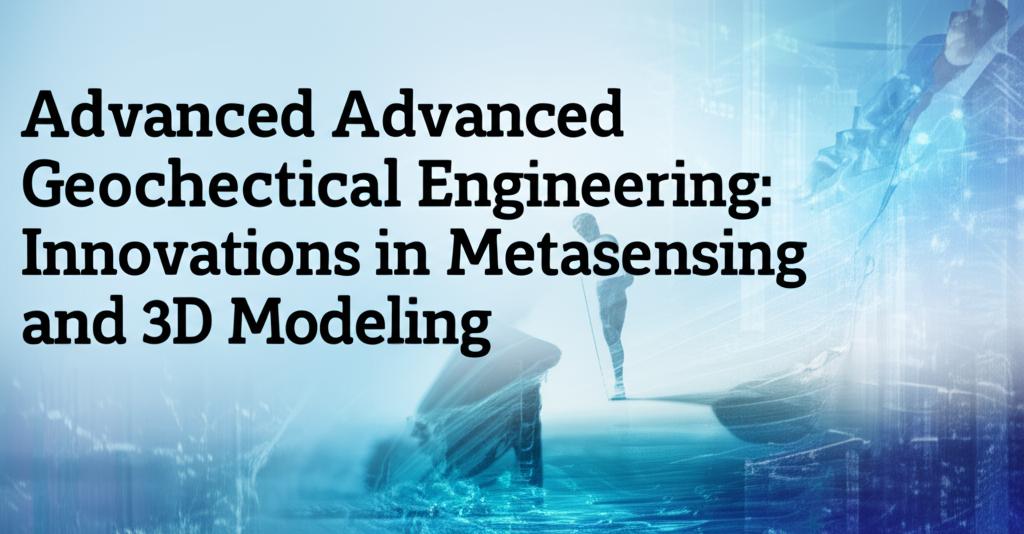The field of geotechnical engineering is rapidly advancing, driven by innovations in metasensing and 3D modeling. These technologies are revolutionizing how engineers approach site characterization, design, construction, and ongoing monitoring of infrastructure projects.
Metasensing: A Paradigm Shift in Geotechnical MonitoringMetasensing, which encompasses a suite of advanced sensing and data collection technologies, is providing unprecedented insights into ground behavior and infrastructure performance. Key innovations in this area include:
- Remote Sensing Techniques: Satellite-based methods like Interferometric Synthetic Aperture Radar (InSAR), hyperspectral imaging, optical imaging, and thermal imaging are transforming infrastructure monitoring. InSAR, for example, is crucial for detecting minute ground movements and deformations over large areas, aiding in landslide and earthquake prediction.
- Fiber Optic Sensors: Known for their sensitivity and durability, fiber optic sensors are ideal for harsh environments. They can monitor strains, temperatures, and displacements within structures, enabling early detection of potential issues.
- Ground-Penetrating Radar (GPR): GPR uses electromagnetic waves to map subsurface features, including soil types, voids, and buried objects, offering a non-invasive and rapid data collection method.
- LiDAR and Drone Surveys: Light Detection and Ranging (LiDAR) combined with Unmanned Aerial Vehicles (UAVs or drones) create highly detailed 3D topographical maps. This technology aids in identifying potential hazards, assessing slope stability, and planning construction more accurately, especially in inaccessible or hazardous locations.
- Internet of Things (IoT) Enabled Sensors: Embedded sensors provide continuous, real-time data on factors like soil moisture, settlement, and structural movements. This allows for proactive maintenance and early warnings of potential problems.
- Artificial Intelligence (AI) and Machine Learning (ML): AI and ML algorithms are increasingly used to analyze the vast datasets generated by metasensing technologies. These tools can identify patterns, predict potential structural issues, optimize resource allocation, and enhance predictive maintenance.
3D modeling is transforming how geotechnical engineers understand and interact with subsurface data. These models provide a comprehensive visual representation of soil layers, rock formations, geological structures, and their interaction with engineered structures.
- Enhanced Site Characterization: 3D geological models integrate various data sources, such as borehole logs, in-situ tests, and geophysical surveys, to create a more accurate and holistic understanding of site conditions. This is particularly valuable for large, complex, or hazardous sites.
- Improved Design and Analysis: By visualizing the subsurface in 3D, engineers can optimize designs for foundations, tunnels, embankments, and other geotechnical structures. Software like Plaxis allows for advanced finite element analysis (FEA) to simulate complex soil-structure interactions, stress distribution, and deformation patterns.
- Building Information Modeling (BIM) Integration: Geotechnical data and 3D models are increasingly being integrated into BIM platforms. This facilitates better collaboration among different engineering disciplines, improves data management, and allows for the creation of "digital twins."
- Digital Twins: These virtual replicas of physical assets, updated with real-time sensor data, allow for ongoing performance monitoring, simulation of various scenarios (e.g., seismic events, changes in groundwater levels), and predictive maintenance throughout the lifecycle of a structure.
- Parametric Modeling: This approach allows for the creation of dynamic 3D models where design parameters can be easily adjusted, and the model updates automatically. This improves design efficiency, reduces errors, and facilitates rapid prototyping of different design solutions.
- Visualization and Communication: 3D models, sometimes combined with Virtual Reality (VR), provide powerful tools for communicating complex geotechnical conditions and design concepts to clients, stakeholders, and construction teams.
The true power of these advancements lies in their integration. Metasensing provides the rich, real-time data that populates and continuously updates sophisticated 3D models. This synergy leads to:
- More Accurate Risk Assessment: By combining real-time monitoring with detailed 3D visualizations, engineers can better identify and mitigate geotechnical risks.
- Optimized and Resilient Designs: Designs can be tailored more precisely to actual ground conditions and anticipated changes, leading to safer and more cost-effective solutions.
- Efficient Construction and Asset Management: Real-time data fed into 3D models allows for better-informed decision-making during construction and throughout the operational life of an asset, enabling proactive maintenance and extending service life.
- Sustainable Development: Improved understanding of ground conditions and material behavior supports the use of more sustainable materials and construction practices, minimizing environmental impact.
Challenges such as managing and interpreting the vast amounts of data generated, ensuring interoperability between different software and sensor systems, and the need for skilled professionals to utilize these advanced tools remain. However, the ongoing development and adoption of metasensing and 3D modeling are undeniably pushing the boundaries of geotechnical engineering, leading to safer, more resilient, and more sustainable infrastructure for the future. Companies are increasingly leveraging these technologies to offer comprehensive monitoring solutions for critical infrastructure like tunnels, dams, bridges, and mining projects. The focus is shifting towards a more data-driven, predictive, and holistic approach to understanding and managing the complexities of the Earth's subsurface.

